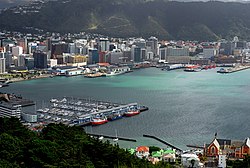
The reclamation of Wellington Harbour started in the 1850s, in order to increase the amount of usable land for the then new City of Wellington. Land plots in the early city were scarce, with little room for public buildings and parks, as well as inadequate dockside areas for shipping. Reclamation progressively advanced into the harbour throughout the 19th and 20th centuries, providing room for public, commercial and industrial areas for the city. Large reclamations were made in the 1960s and '70s to meet the demands of container shipping and new cargo handling methods.[ citation needed ] [1]
Contents
- Establishment of Wellington
- 19th century reclamations
- Early reclamations
- Establishment of the Wellington Harbour Board
- 20th century reclamations
- Thorndon reclamations
- 1960s and container shipping
- Port reforms
- Marking the original shoreline
- Timeline of reclamations
- See also
- References
- External links
For over 100 years, development was largely overseen by the Wellington Harbour Board, formed in 1880. As one of the outcomes of the 1989 local government reforms, an operating company Port of Wellington (now CentrePort Wellington) was formed. At the time it commenced operation in 1989, it owned approximately 72 ha (180 acres) of Wellington waterfront property including wharves. The remainder of the Wellington waterfront area from Shed 21 to Clyde Quay Wharf, including all the buildings, was transferred to Wellington City Council. Since then, the formerly industrial waterfront has been converted into office space and public areas.[ citation needed ] Reclamation has added more than 155 hectares to Wellington. [2]





